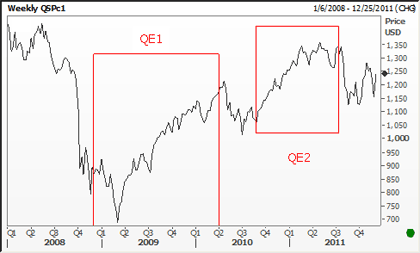Monetary Collusion Masking A Vulnerable Aussie Dollar
This week global central banks announced a coordinated effort to inject liquidity into credit markets. From Reuters:
“The central banks of the United States, euro zone, Japan, Canada, Britain and Switzerland announced on Wednesday coordinated global action to provide liquidity to the financial system, lowering the price on existing dollar swaps.”
As frequently as these monetary powers must work together in world-saving plans, this is only the third instance of this particular type of announced collusion.
The first was in December 2007. The second was in September 2008.
Here is what happened then:

Not exactly the market reaction we’ve come to know from the more popular (and admittedly larger) quantitative easing measures implemented by the Federal Reserve.
Here is the QE1 and QE2 impact on the S&P 500 as a reminder:

The financial markets’ kneejerk reaction this week to the coordinated central bank action was one of optimism. But I doubt that optimism can carry on the back of a mere “coordinated effort.”
First, we know that things in the euro zone are not improving and the economy will only worsen. And we know that the stop-gap solutions proposed by euro-zone leaders cannot really succeed.
Second, China’s economy is not playing along …
I’ve harped on a potential Chinese hard landing for some time. And I figured investors would turn their attention to China once they got tired of the euro-zone debacle. But because of so many new proposals to fix the euro zone, investors have not tired out and caved in to the ultimate fate.
China, with simmering troubles in its economy very much ignored by mainstream investors, is firmly in a slowdown phase. The People’s Bank of China has cut its required reserve ratio for the first time in about three years. This is clearly an admission of sorts that they’re not comfortable with the slowdown in their industrial and real estate markets.
A shift of focus toward China, even if for only a week or two, could very much counteract the market optimism stemming from the newest global central bank activity. As shown in the chart below, China’s Purchasing Managers Index, a popular gauge of the manufacturing sector, declined to a level of contraction lower than expected.
Not good.

And a look at the Shanghai Composite index compared to the Australian dollar sheds some light on the current divergence in market sentiment:

As you know, the Australian economy has become quite the satellite economy for China (NYSEARCA:FXI). While Australia is not on the verge of collapse, far from it, its heavy exposure to China will likely cause a readjustment in the Australian dollar.
Here’s why …
Iron ore and coal account for 39 percent of Australia’s exports. And China imports 70 percent of Australia’s iron ore exports. Since the steel sector is highly exposed to a slowdown in China, that could easily lead to a reduction in demand for Australia’s iron ore.
So while the market is wrapped up around central bank action, expecting some sort of risk appetite celebration, you should be open to the idea that risk currencies, such as the Australian dollar, could become quite vulnerable if China’s slowdown becomes a concern that global monetary intervention cannot immediately address.
When you consider that risk, you need to ask if the spike in the Australian dollar (NYSEARCA:FXA), as shown in the AUD/USD daily chart below, is warranted.

Fundamentally, I think not. And we’ll soon see if investors find reason to change their tune.
View original article:
Monetary Collusion Masking A Vulnerable Aussie Dollar (FXA, UUP, FXI, EEM, VWO)
Comments
Leave a Reply
You must be logged in to post a comment.